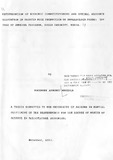| dc.description.abstract | Research on rainfed rice production and its competitiveness on
Smallholder farms of Amukura Division of Busia District was carried
out in February, March and April 1991. The data were collected using
a structured questionnaire which was administered to fifty farmers.
The specific objectives of the study were:-
(i) To describe the farming system in which rainfed rice
farming is found and to determine the various farm
resources available to rainfed rice producers.
(ii).To determine the relative profitability of rainfed rice
production vis-a-vis other competing enterprises.
(iii)To find out if rainfed rice could feature in the
optimal farm plans.
The analytical methods used to achieve the above objectives were
Gross Margin Analysis and Linear Programming.
The results of the study showed that rainfed rice was excluded from
the optimal farm plans for the large and aggregated farm models; rice
was included in the optimal plan for the small rice farm model, but
at a relatively low hectarage of about 0.18. Parametric Linear
Programming showed that for rice to be profitably produced and be
included in the optimal farm plans substantial increases in producer
prices of paddy rice would have to be effected by the Government. Also
for the farmers to put at least 1 ha under rice, which is being aimed
at by the LBDA and Ministry of Agr icul ture, price alone is not
sufficient.
The sensitivity analysis results showed that when price is increased
to Ksh.8 about 0.88 ha will be planted and also when price is at
Ksh.l0 still -0--.--8-8- ha will be put under rice. Hence other factors of
production as well as favourable prices will have to be looked into
if rainfed rice productions is to be improved.
The results of the analysis,of non-rice farm models showed that
cotton grown in the second season, maize grown in the second season
and cassava were the most profitable enterprises in the optimal farm
plan for the small non-rice farm model. On the large and aggregated
non-rice farm models, cassava, maize grown in the first season and
sorghum gr9wn in both the first and second seasons were the most
profitable enterprises.
The study concludes that rainfed rice is unprofitable to produce
at the prevailing economic conditions in the Amukura area. The study
recommends that:
(i) the government should increase the producer price of rice.
(ii) ways should be found to ease the operating capital
constraint by offering short term credit to farmers in the
study area.
(iii) the extension staff should develop optimal plans for
the non-rice farms of this area. This will enable farmers to
optimize resource use.
(iv) price increases alone are not sufficient to
increase rice output as shown by the results of the
sensitivity analysis. Therefore, farmers should be
educated on modern ways of rice production. | en |

